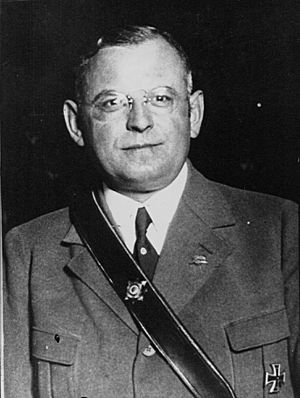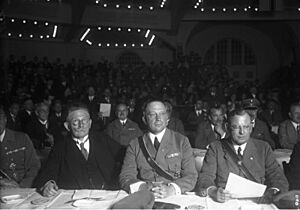Franz Seldte facts for kids
Quick facts for kids
Franz Seldte
|
|
|---|---|

Franz Seldte, 1933
|
|
| Reich Minister for Labour | |
| In office 30 January 1933 – 23 May 1945 |
|
| President |
|
| Chancellor |
|
| Preceded by | Friedrich Syrup |
| Federal Leader of the Nationalsozialistischer Deutscher frontkämpfer-Bund (Stahlhelm) | |
| In office 28 March 1934 – 7 November 1935 |
|
| Federal Leader of Der Stahlhelm | |
| In office 25 December 1918 – 28 March 1934 |
|
| Personal details | |
| Born | 29 June 1882 Magdeburg, German Empire |
| Died | 1 April 1947 (aged 64) Fürth, Bavaria, Allied-occupied Germany |
| Resting place | St Laurentius Cemetery, Rottach-Egern, Germany |
| Political party | National Socialist German Workers' Party (1933–1945) |
| Other political affiliations |
German National People's Party (until 1933) |
| Alma mater | Brunswick University of Technology |
| Signature | |
| Military service | |
| Allegiance | |
| Branch/service | Imperial German Army |
| Years of service | 1914–1918 |
| Rank | Hauptmann d.R. |
| Unit | 66th Infantry Regiment |
| Battles/wars | World War I
|
| Awards |
|
Franz Seldte (born June 29, 1882 – died April 1, 1947) was a German politician. He served as the Minister for Labour in Germany from 1933 to 1945. Before becoming a minister, Seldte led an organization for soldiers who had fought in World War I. This group was called Der Stahlhelm. He was the leader of Der Stahlhelm from 1918 to 1934.
Contents
Early Life and Education
Franz Seldte was born in Magdeburg, which was then part of the German Empire. His father owned a factory that made chemical products and soda water. Franz went to school in Magdeburg. After finishing school, he trained to be a salesman.
Later, he studied chemistry at universities in Braunschweig and Greifswald. In 1908, he took over his father's business because his father passed away early. During World War I, Seldte was an officer in the German Army. He was injured and lost his left arm. He then became a reporter from the front lines. He received two important awards, the Iron Cross 2nd and 1st class. He was also promoted to the rank of Hauptmann d.R., which means Captain in the reserves.
Der Stahlhelm Organization
After World War I ended, Franz Seldte started an organization called Der Stahlhelm (The Steel Helmet) on December 25, 1918. This group was for soldiers who had fought in the war. They were unhappy with the Treaty of Versailles, which was the peace agreement after the war. They also disagreed with the large payments Germany had to make to other countries. Seldte believed the group would use the spirit of the former soldiers to influence Germany's government.
From 1923, Seldte was in charge of Der Stahlhelm. However, he often had disagreements with his deputy leader, Theodor Duesterberg. Seldte also joined a political party called the German National People's Party (DNVP). He became a member of the city council in Magdeburg.
As the years passed, Der Stahlhelm became more against democracy and the German government of that time, known as the Weimar Republic. Seldte hoped his organization could lead a united right-wing movement in Germany. In 1929, Der Stahlhelm joined forces with other groups, including the Nazi Party. They tried to get people to vote against a plan about Germany's war payments, called the Young Plan. Their goal was to show that the Chancellor and his ministers were not loyal to their country. However, their vote did not get enough support. In 1931, Seldte also helped create a short-lived alliance called the Harzburg Front. This group was against the government at the time.
Minister for Labour
In January 1933, when leaders were deciding who would become Chancellor of Germany, Seldte supported Adolf Hitler. Because of Seldte's support and the backing of Der Stahlhelm, Hitler became Chancellor. On January 30, 1933, the day Hitler took power, Seldte joined Hitler's government. He became the Minister for Labour.
In April 1933, Seldte officially joined the Nazi Party. He also merged Der Stahlhelm into the Sturmabteilung (SA), which was a large Nazi group. This meant Der Stahlhelm was now under Hitler's control. In August 1933, Seldte was given a high rank in the SA. He was also put in charge of a volunteer work program. However, another person, Konstantin Hierl, soon took over this program. Seldte also became a member of the Academy for German Law. In 1934, Seldte was made the leader of a new group that replaced Der Stahlhelm. But this new group was soon dissolved. In 1935, Seldte asked to leave his government duties, but Hitler said no.
During his time as Minister for Labour, Seldte did not have much real power. Hitler did not think highly of him. Other Nazi leaders started to take over his responsibilities. For example, Hermann Göring started a "Four Year Plan" in 1936. This plan took away many of the duties that belonged to Seldte's Labour Ministry. Seldte remained Minister for Labour until the end of World War II. He was also a State Labour Minister in the government of Prussia under Hermann Göring.
As the Minister for Labour, Franz Seldte signed a law in 1934 called the Work Order Act. This law introduced the "Führer principle" in factories. This meant that the leader of a factory had complete authority. It also greatly limited the rights of workers.
Death
Franz Seldte was captured and arrested at the end of World War II. This happened in Mondorf-les-Bains. During the Nuremberg trials, Seldte tried to say that he had been against Hitler's rule. He claimed he wanted a government with two parts, like a parliament. However, his explanation was not believed. Seldte died in a US military hospital in April 1947 in Fürth. He passed away before the Nuremberg Tribunal could formally put him on trial for the charges against him.
Legacy
In Nazi Germany, some streets were named after Franz Seldte. These included streets in his hometown of Magdeburg and in Leverkusen. In Forst (Lausitz), a football stadium was named Franz-Seldte-Kampfbahn. In Oberhausen, a square behind the main train station was also named after him.
See also
 In Spanish: Franz Seldte para niños
In Spanish: Franz Seldte para niños


